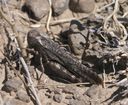Red-winged Grasshopper
Arphia pseudonietana
Classification
- Phylum: Arthropoda
- Subphylum: Hexapoda
- Class: Insecta
- Order: Orthoptera
- Suborder: Caelifera
- Family: Acrididae
- Subfamily: Oedipodinae
- Tribe: Arphiini
- Genus: Arphia
- Species: pseudonietana
Pronunciation
How to pronounce Arphia pseudonietana: /ˈɑrfɪə ˌsjuːdoʊniːˈɛtænə/
These audio files are automatically generated. While they are not always 100% accurate, they are a good starting point.
Images






Summary
Arphia pseudonietana, commonly known as the red-winged grasshopper or red-winged locust, is a species of band-winged grasshopper found in parts of Central and North America, notable for its distinctive wing color and widespread presence in open grassy habitats.
Physical Characteristics
Adults most abundant late in season, with hind wings usually rich orange-red to blood red (rarely lighter orange or yellow) and always with wide black borders. Body coloration is dark, usually grayish to black, sometimes speckled darker (especially in females), with white to tan patches on head, pronotum, and/or legs. Abdomen and ventral surface very dark, usually black in males. Hind tibiae usually nearly black, occasionally tinted brown or blue.
Identification Tips
The hind wings are characterized by their red color and distinct black borders. Males have black abdomens, while females may have lighter speckling. It can be distinguished from its closely related species, A. xanthoptera, by the color of its wings and the low crest of the pronotum.
Habitat
Most any open sunny area where there is bare ground and grass.
Distribution
Southern British Columbia to southeastern Ontario, and south to central Mexico, mostly found in western and Midwestern regions, and is mostly absent from the Mississippi and Ohio River Valleys, and from California west of the Sierra Nevada.
Diet
Probably mostly grasses.
Life Cycle
Overwinters as eggs that hatch in spring, with adults from late June or July until freezing weather.
Ecosystem Role
A striking and often noticed species due to its commonality and behavior, contributing to the ecological dynamics of grassy areas.
Evolution
From Greek pseudos (ψευδος)- "false" + nietanus, referring to a closely resembling Mexican species.
Similar Taxa
- A. xanthoptera
- A. saussureana
Tags
- grasshopper
- Acrididae
- orthoptera
- insect
- ecological role